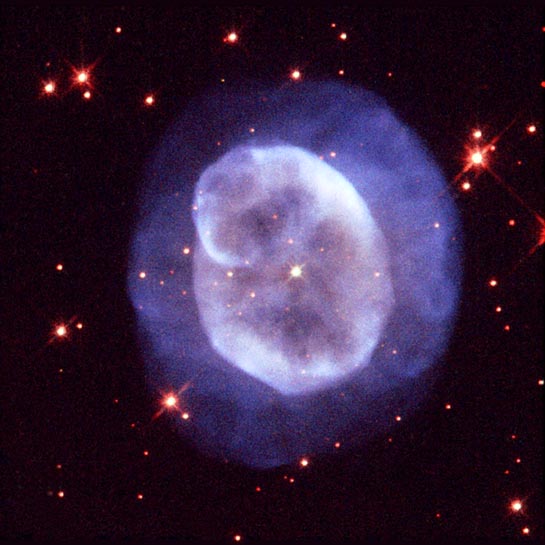
Planetary Nebula
RA 15h 47m 41.16s Dec -61° 13' 05.6"
Triangulum Australe
9000 light years
11.5
0.25 X 0.25 arcmin
ESA, ESO and NASA
July 8, 2004
ABOUT THIS IMAGE:
This previously unreleased colour image of the planetary nebula NGC 5979 is a composite of raw FITS files made with the ESA/ESO/NASA Photoshop FITS Liberator. The image was composed from four individual exposures taken through: A blue narrow-band filter (502 nm, 460 seconds showing the forbidden OIII line), A green wide-band filter (555 nm, 240 seconds), An orange-red narrow-band filter (658 nm, 1200 seconds showing the forbidden NII line), A red, or near-infrared, wide-band filter (814 nm, 480 seconds).
Stars like the Sun spend most of their life quietly converting hydrogen into helium. However when the hydrogen in the stellar core is exhausted, they start a short phase of much more rapid evolution, growing in size and brightness, to become cooler red giants that begin to eject large amounts of gas and dust as a slow stellar wind.
When the star has lost most of its mass, it heats up again and brightens so that the ejected material begins to glow. At the same time a faster wind sweeps through to clear out the cocoon of obscuring material and so a planetary nebula is born.
From Wikipedia:
NGC 5979 is a planetary nebula in the constellation of Triangulum Australe near the boundary with the constellation of Norma. It was discovered on April 24, 1835 by John Herschel .
Of slightly elliptical appearance, the estimated distance of NGC 5979 to Earth, based on metallic emissions, is about 11,700 light years away. Stars like the Sun spend most of their lives converting hydrogen into helium. When hydrogen is exhausted in its core, they expand and cool, becoming red giants and begin to shed large amounts of gas and dust through a gentle stellar wind. When the star has detached from most of its mass, the star heats up again illuminating the ejected material, while a much stronger stellar wind sweeps the cocoon of dark material and the planetary nebula is born.